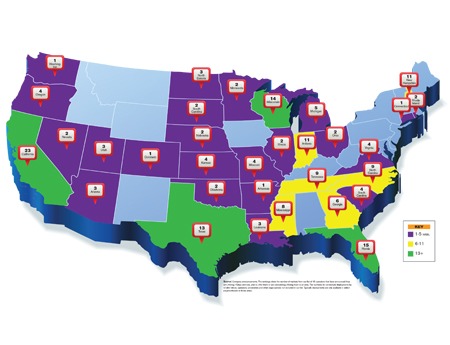The Gigabit Map

Google Fiber's subscriber counts may be small — MoffettNathanson estimated they were under 30,000 at the end of 2014. But the Mountain View search giant’s push to launch gigabit services and build fiber-to-the-home (FTTH) networks has certainly pushed a wide range of larger telcos and cable operators to boost average broadband speeds and increasingly roll-out 1gig Internet connections.
The extent of that influence can be seen in Next TV’s first ever Gigabit Map. In the following pages, the Gigabit Map project shows existing and upcoming deployments of 1-Gigabit-persecond services by major telcos and cable operators on a map of the U.S. and in listings broken down by company.
While the Gigabit Map highlights the rapid proliferation of these ultrahigh-speed services, it is important to stress that it both understates and overstates the footprint of 1 Gbps services.
The website, Broadbandproperties.com, currently lists 977 companies and organizations that have been deploying fiber-to-the-home networks, though only a smaller subset of those operations provide 1 Gbps services. Our list focuses on 15 major telcos and cable operators who have at least a significant national or regional footprint. As a result, it excludes hundreds of local telcos, universities, municipally owned ISPs, public utilities, co-ops and other smaller commercial or not-for-profit operations.
We’ve also limited the listings to residential services providing speeds of at least 1 Gbps and excluded deployments of services that are only available to businesses.
If these listings understate the extent of the Gigabit revolution by excluding many local initiatives, they could also be misconstrued to indicate that 1 Gbps broadband speeds are widely available. They aren’t. In interests of space, we’ve listed whole cities or metropolitan areas but in practice the offerings are limited to select neighborhoods and in some cases only a few housing developments.
This reflects the fact that almost all of the services currently available by telcos and cable operators have been rolled-out by building FTTH, a fairly laborious process that takes considerable time and capital.
Broadcasting & Cable Newsletter
The smarter way to stay on top of broadcasting and cable industry. Sign up below
In the next few years, this will change as DOCSIS 3.1 becomes more widely available towards the end of 2016 and more cable operators upgrade their networks to handle it. These upgrades will play a key role in plans by operators such as Cox Communications to make 1 Gbps services available to all its customers or Suddenlink’s plans to have it in 90% of its footprint by the end of 2016.
The map also shows how some companies are already pushing beyond 1 Gbps services, with Comcast having rolled out symmetrical 2 Gbps in a number of cities, and the competitive pressures that are driving companies to speed up their networks. Some cities, such as Austin, Texas, now have several providers vying to roll out 1 Gbps services and other providers, such as Charter, that have not yet jumped into the Gigabit game have been ramping up their available speeds in response to the increased competition.
Such threats may push more into the Gigabit speed race. Time Warner Cable announced that it would consider providing 1 Gbps services after the Los Angeles City Council voted to explore a municipal system. Likewise, Verizon, which has a fiber network capable of delivering 1 Gbps but has said there isn’t market demand for them, may shift its strategy if consumers embrace these services, which are still relatively expensive.
Gigabit speeds are emerging as video continues to soak up an increasing share of overall IP capacity, and as programmers and other content providers develop and launch bandwidth-intensive 4K/Ultra HD and virtual reality apps and services. In its latest Visual Networking Index study, for example, Cisco Systems predicts that IP video will represent 80% of all traffic by 2019, up from 67% in 2014, and that HD and Ultra HD Internet video will eat up 63% of Internet video traffic by 2019.
The following list of deployments was collected by scouring a wide array of published accounts and press releases and then contacting the companies to verify the information. The data is current as of July 17.
The listings show whether a deployment is currently available, planned or under consideration by state, city and operator. Some providers have not announced specific cities but have made general announcements about their footprint. Those announcements are listed under the category of “Other.”
Click HERE to view existing and upcoming deployments of 1-Gigabit-per-second services by major telcos and cable operators in listings broken down by company.










